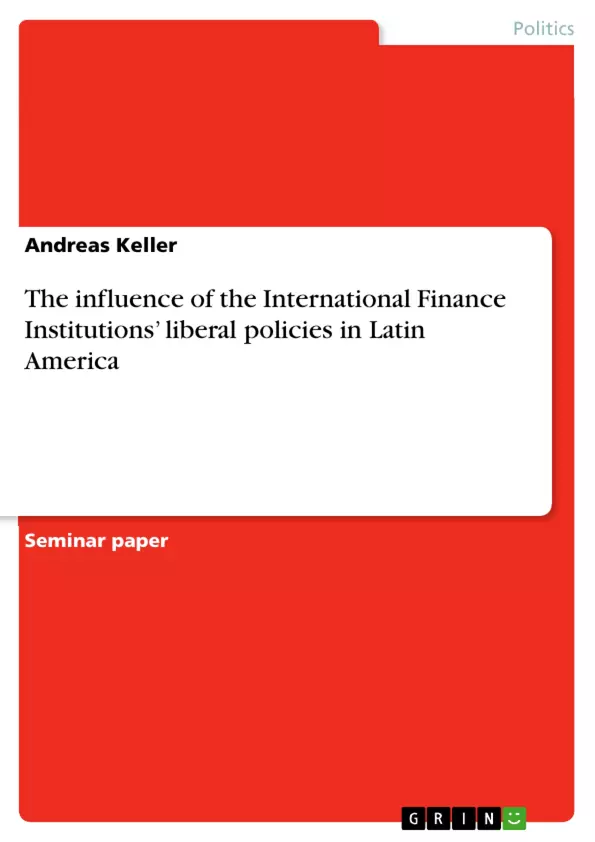Regularly, the International Finance Institutions (the World Bank and the International Monetary Fund)are critized harshly by Latin American leaders - Venezuela's Hugo Chávez even called them a “curse” for Latin America, and condemned its "shock politics that have spread hunger, misery, poverty and violence to our peoples." The “Banco del Sur”, a new development bank recently founded by Venezuela and six other Latin American countries, is seen as an answer to the IMF and the World Bank.
Criticism like this is common in Latin America. Some points are quite understandable: In the International Monetary Fund, which is responsible for monitoring the global financial system, the United States de facto has a veto power. Other Western industrial nations make up for the majority of the vote. The same applies to the World Bank whose president always is appointed by the President of the United States. It is hard not to suspect US political interests behind this appointment: Two World Bank presidents – Robert McNamara and Paul Wolfowitz – came from the US Department of Defense, where they were responsible for leading controversial wars like Vietnam or Iraq.
These criticisms are well-known. This paper thus concentrates on the actual work of the International Finance Institutions in Latin America, the implementation of their policies and how they affected the subcontinent. Their influence is enormous: some hold the IMF and the World Bank responsible for severe crises that nearly lead to collapses of nations and for the ongoing underdevelopment of Latin America. Indirectly they are also blamed for the current enormous resurgence of leftist movements, which all declared the International Finance Institutions one of their main enemies. As the measures of the IMF and the World Bank are intertwined, they will be depicted together. First, the conceptual framework of the IMF, the World Bank and the “Washington Consensus” will be presented, followed by a short summary of Latin American economic history from the 1950s to the 1990s. Then the different measures of the structural adjustment package of the Bretton Wodds Institutions, their impact (illustrated by different country examples) and outcomes will be discussed in detail. Finally this paper will give attention to the “Banco del Sur”, a development bank very recently founded by seven Latin American nations that should make these countries independent from perceived Western influence through the IMF and the World Bank.
Inhaltsverzeichnis (Table of Contents)
- I. The reputation of the IMF and the World Bank in Latin America
- II. The economy of Latin America in the second half of the 20th century
- 1. 1950-1990: Import substitution and the “década perdida”
- 2. The neoliberal “revolution” and the “Washington Consensus”.
- III. The structural adjustment package of the Bretton Woods institutions and its consequences
- 1. Trade liberalization
- 3. Privatization
- 4. Cutting social security contributions
- 5. Case study: Argentina
- IV. The new \"Banco del Sur\" as an alternative?
- 1. Founding and aims
- 2. What is to be expected?
Zielsetzung und Themenschwerpunkte (Objectives and Key Themes)
This paper examines the actual work of the International Finance Institutions in Latin America, specifically the implementation of their policies and their impact on the subcontinent. It aims to shed light on the influence of the IMF and the World Bank, including their role in economic crises and the ongoing underdevelopment of the region.- The reputation of the IMF and the World Bank in Latin America
- The economic history of Latin America from the 1950s to the 1990s
- The impact of the IMF and World Bank's structural adjustment packages
- The rise of leftist movements in response to IMF/World Bank policies
- The emergence of the "Banco del Sur" as a potential alternative
Zusammenfassung der Kapitel (Chapter Summaries)
- Chapter I provides an overview of the IMF and World Bank's reputation in Latin America, highlighting criticisms related to their political influence and potential biases. It introduces the main themes of the paper: the IMF and World Bank's policies and their impact on Latin American economies.
- Chapter II explores the economic history of Latin America, focusing on two distinct periods: the period of import substitution (1950-1990) and the neoliberal “revolution” following the “década perdida”. This chapter provides context for understanding the role of the IMF and World Bank in shaping Latin American economic policy.
- Chapter III details the various aspects of the IMF and World Bank's structural adjustment package, including trade liberalization, privatization, and cuts to social security. The chapter discusses the consequences of these measures on Latin American economies, using Argentina as a case study.
Schlüsselwörter (Keywords)
The main keywords and focus topics of this text include the International Monetary Fund (IMF), the World Bank, the Washington Consensus, structural adjustment programs, Latin American economies, trade liberalization, privatization, debt crisis, and the "Banco del Sur". The work explores the impact of neoliberal policies on development in Latin America, the influence of US political interests on these institutions, and potential alternative development models.- Quote paper
- Andreas Keller (Author), 2008, The influence of the International Finance Institutions’ liberal policies in Latin America, Munich, GRIN Verlag, https://www.grin.com/document/157895



